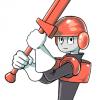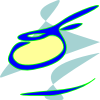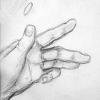Your description of this diagram makes it sound like a very impressive system. I would build the outside abilities and skills and work inward, I don't doubt this system already has a sizable amount of skills already planned, which you could easily depict on this diagram but the skill is only half the battle. Since the reason for diversity in skills is to answer the diversity of puzzles, enemy and level design challenges (hope that makes sense) you need to depict the skills within that diagram and build a diagram of challenges to match it.
So to start obviously you'd have one quintessential Mind, Force and Spirit skills that each answer a type of challenge and a few bosses that explore combinations of these skills. After these three you move toward the center (of your triforce of power;) creating one skill for each image you have depicted and again creating specific challenges to justify these skills.
The reason for this is because players earn the most sense of accomplishment from feeling like they've figured out a system. Once you've established some obvious skills that sit in the diagram, begin churning out as many other challenges as you can and start using the remainder of individual skills or combinations to answer those challenges. I would create icons for all of them personally since clear visual depiction helps express ideas much more clearly. I think you'll find the game design becomes very heavy, very quickly and will help you choose the skills that matter the most. You have a solid visual start at expressing this idea, keep at it.
Ah, thank you, although, the graph is a diagram relating to the stats for a competitive battle game. There are no puzzles present in the game design other than trying to figure out the fighting style of your opponent and adapting to it in combat. I mean, it could be a mini-game if the game were expanded on and became really popular to the point where players would want to initiate in mini-games relating to their stats. As for combat skills, in the game itself, many kinds of techniques exist that pertain to this diagram. For example, fireballs would purely fall in the spirit section, the very top corner, techniques like punches and jabs fall at the very corner of the left corner and something like telepathy, or the ability to read the opponents next move right when they initiate it but before they launch it, would fall in the right corner.{And the game system is built in such a way to allow such a thing.}
To describe the diagram more in depth, what it does in game is that after a player has inputted their stats before the start of the game{just an example: you can set your base stats from a minimum of 1 to a maximum of 50, with a total starting pool of say 250, and by the games rules, you only need 1 stat from each of the other categories minus Essence, which requires that any of the three have at least 1 point}, the diagram would mark a spot on the triangle in relation to their stats. In other words, it is also a visual helper to the player in figuring out what types of techniques they are best suited to using and all techniques they will come across within the game will show where on the diagram they fall under{techniques can be learned via books items, fighting at certain locations, npcs, fighting certain monsters, etc. but none via "level up" as there is no leveling system, you can gain something akin to experience points, but they are used for other things such as an important gameplay feature that allows you to create your own custom technique, as well as using experience points to create "books items" with a technique you made or know to give/trade to other players}. Back to the diagram and how it helps players with their stats: for example, if their dot were to fall at the very corner of the bottom left, it would mean they would only be effective with physical techniques such as martial arts, bladed weaponry, etc,{depending on what "masteries" they set up in the Intellegence/Hidden Potential/Skills graph, which reflects this graph in being a triad, but focuses on the usage and mastery of techniques, rather than the attributes of the character which is covered by the three aspects graph. I'll have to illustrate that other diagram soon, but for now, it is mentioned in the "character" section of this mock up site I made for practice, in preparation for the actual site:
http://www.grydpher.netne.net
Also, the center of the diagram represents somebody who can use all three aspects, but their limit in all three is lower. They can however still match somebody who purely invested in a single stat via the usage of techniques that make the most out of their stat spread, as well as the innate advantage of having a more versatile movepool.
I have thought this system out well, for years, and hoping that this year, I can finally make it into a game
That's a very small subsystem and not a very important one I would say. You can't make a game based on that one alone. How the game area/map will look like? How you move? How battle is initiated (on the game map/separate battle screen)? How many characters are in the party?
For example, if you have more than one character in the party I would say this system would not work (no point in jacks of all trades), but if just one it could be fine.
The biggest danger of starting with this subsystem I see is that you can get too attached to it. Let's say you did the prototype and it turns out it's not so fun and that classes would fit better with the rest of the game. What would you do then, would you be willing to discard it?
My advice would be to start with the basics. Make a map and some character/party moving around, when they encounter a monster the battle starts (simple damage and HP, nothing more). This gives them gold and experience. Experience grants level up which increases damage and HP.
I know it sounds trivial, but really, I was doing various RPGs most of my life and I can vow that this is the best way of starting such game (you can add extras like complex battle system later).
It is a small subsystem, but its not the only one in the game{I was actually referring to the game's entire system in general when I said that quote, sorry it sounded vague.}. The thread is about determining a player's abilities, which is what this diagram is about and how it does it without having to rely on word style restrictions{i.e. warrior can't cast lightning bolt because only mage classes can}, the game uses purely numerical limitations while allowing a player to use any technique they wish, no matter how ineffective it will be on them.
If you think of this diagram in traditional rpg terms, it is overly complicated and unnecessary, however, this game isn't solely an rpg, and is actually a hybrid of three different competitive genres. Because of that, a traditional rpg stat spread is very limiting and why the game design demanded something more complex, but also needed to be self-correcting, without the use of verbal restrictions found in many games.
Also, as I mentioned to the posted in the message above this, this diagram illustrates where you would fall in the graph fater inputting your stats at the start of the game.

For example, by the rules of the game, you only need a single stat in each column minus Essence which requires all three. The reason for this being that say, you only need a single stat for accuracy to be able to target or detect anything, you only need a single offense stat to use techniques, you need any stat in speed to have mobility, and so on. The game allows those stats to be at 0, but then you'd have a very messed up character that can't properly fight or move.{For example, if you have 0 in speed stats, your character is basically as immobile as a rock, but if you have something in the offense category, and somehow acquired the technique for it, you could "move" around by attacking the ground to push yourself around.{This kind of thing is also why the game system is part simulation, as it has physics to its battle system otherwise not present in a traditional rpg}. And thus, why I've called it a hybrid game.
All those game features you mentioned {game map, how the game starts out, etc.} have already been planned out, as I mentioned, this thread was about the discussion of this sub system. I apologize if it didn't appear that way. The game document itself, although divided into several files, totals somewhere over 60 pages in length, and I gotta organize it all into something that's easy to interpret and understand for an interested game team. I practiced making a site trying to present the game in the easiest to understand manner:
http://www.grydpher.netne.net
<This site is for practice, although I created all the art, I need to include mock up art of the actual menus, as well as proper mock up regarding the character creation system and the website layout needs to be better improved. The game's actual name is Fulgryph.
Also, to give an example of how the game starts: If your going into storymode and not just straight to online competitive play, you are first taken to a character creation screen to create your looks, after which your character is put on a mission with 7 NPC allies. You come across a horde of enemy creatures, and your npc allies begin to fight, after you've seen how each fights,{each npc will represent a symbol on the diagram, for example, the area between spirit and mind are those who can use both techniques of those kinds, as well as use the "MIXED" techniques, which combine both of those aspects to create a new kind of attack. For example, an "Energy bomb" technique is a spiritual attack compressed into a sphere by the force of the mind to detonate upon impact.} Somebody in the area between Form and Spirit could use say, a sword imbued with spiritual flames to increase its attack power, etc.
After you've seen the NPCs fight, time is frozen and you will be able to highlight each character as they were in mid-battle, with a menu showing information on each fighting style, the three aspects stat distribution, and the I.H.E.{Intellegence, Hidden Potential, Skills} set up, at this point, you are either asked if you want to copy that set up of said character, or create your own, in either case, you are taken to a screen where you can set up your stats and select your I.H.E. limits. You are also give your weapon at this point. Once that is done, you are thrown into the fray to assist the other 7 NPCs. Afterwards, when you return to town, the party disbands and you are free to roam around the game world, go to multiplayer competitions, or play in storymode, which has you travel the world map to defeat 5 powerful bosses and along the way, practice in your chosen fighting style, while acquiring new techniques and skills.
I could type out more about the game's other features, but it's too lengthy to discuss here. I would need to make a different topic discussing the game itself.
My main goal right now is to just make a demo demonstrating the fighting system, which over half of the features hasn't been discussed in this thread since a special system is what manages the combat and stats represented in the three aspects image. I have attached an image from one of my game design documents discussing the menu relating to the combat system. I have the game mostly documented already, I just have to organize it and present it in a simpler way as I've mentioned already.
Also, regarding my game design experience, I've been desgining games since I was in the single digits of age, when I made a board game regarding whale survival in the open ocean. After making a few games from paper like bug chess and various others over the years, I began to study up on video game design around 13. Shortly after I began work using a game engine and created about three different games over the span of my high school days before I strayed away from games in general and focused on art. In the meantime, I just passively worked on game design ideas for the next few years in my spare time. This game design project is my favorite out of the few I've had been working on. I never attempted to turn it into a game on my own as I know how many years a single person can spend on a game doing everything, and only get so much done. Next time, I'll work in a team in order to bring this game to fruition sooner.
So if I do manage to get a team, I can serve as both Game Designer and Concept Artist.












